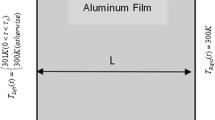Abstract
Phonon transport in an aluminum thin film is simulated due to a temperature disturbance across the film. The Boltzmann equation is introduced to formulate the radiative transport in the electron and lattice sub-systems. The transient and frequency dependence of the phonon transport is considered, and dispersion relations are accommodated to account for the group velocities in the analysis. Electron-phonon coupling is employed to couple the energy transport across the electron and lattice sub-systems. An equivalent equilibrium temperature is presented to assess the characteristics of the phonon intensity in the film. Temperature predictions are validated with data presented in a previous study. It is found that the equivalent equilibrium temperature differs significantly from that obtained from the two-equation model. The film thickness influences the transport characteristics of the film, in which case the time to reach an almost quasi-steady temperature is shorter for the thin film (\(L_{x}= 0.25 \,\upmu \hbox {m}\), where \(L_{x}\) is the film thickness) than that corresponding to the thick film (\(L_{x}= 2 \,\upmu \hbox {m}\)). In the diffusion limit (when the Knudsen number \(Kn=\varLambda /{L_x }\rightarrow 0\), where \(\varLambda \) is the mean free path), it is demonstrated that the radiative transport equation reduces to the formulation of the two-equation model.











Similar content being viewed by others
References
B.S. Yilbas, A.Y. Al-Dweik, S. Bin, Mansour. Phys. B 406, 1550 (2011)
B.S. Yilbas, S. Bin Mansour, Numer. Heat Transf. Part A 64, 800 (2013)
S. Bin Mansoor, B.S. Yilbas, Opt. Laser Technol. 44, 43 (2012). doi:10.1557/PROC-639-G6.38
J.M. Hayes, M. Kuball, Y. Shi, J.H. Edgar, Raman Analysis of Single Crystalline Bulk Aluminum Nitride: Temperature Dependence of the Phonon Frequencies, in MRS Proceedings (2000), doi:10.1557/PROC-639-G6.38
D.Y. Song, M. Holtz, A. Chandolu, S.A. Nikishin, E.N. Mokhov, Y. Makarov, H. Helava, Appl. Phys. Lett. 89, 021901 (2006)
V. Samvedi, V. Tomar, J. Appl. Phys. 114, 034312 (2013)
M. Bickermann, B.M. Epelbaum, P. Heimann, Z.G. Herro, A. Winnacker, Appl. Phys. Lett. 86, 131904 (2005)
S.S. Ng, Z. Hassan, H. Abu Hassan, Appl. Phys. Lett. 90, 081902 (2007)
S. Mizuno, N. Nishiguchi, J. Phys. Condens. Matter. 21, 195303 (2009)
Y. Chen, M. Chu, L. Wang, X. Bao, Y. Lin, J. Phys. Status Solidi A 208, 1879 (2011)
H.S. Huang, A.K. Roy, V. Varshney, J.L. Wohlwend, S.A. Putnam, Int. J. Therm. Sci. 59, 17 (2012)
N. Donmezer, S. Graham, Int. J. Therm. Sci. 76, 235 (2014)
A. Pattamatta, Int. J. Therm. Sci. 49, 1485 (2010)
L.-C. Liu, M.-J. Huang, Int. J. Therm. Sci. 49, 1547 (2010)
B.S. Yilbas, S. Bin Mansour, Phys. B 407, 4643 (2012)
B.S. Yilbas, S. Bin Mansour, Transp. Theory Stat. Phys. 42, 21 (2013)
R. Stedman, G. Nilsson, Phys. Rev. 145, 492 (1966)
A.C. Bouley, N.S. Mohan, D.H. Damon, in Thermal Conductivity, vol. 14, ed. by P.G. Klemens, T.K. Chu (Springer, New York, 1976), p. 81
A. Majumdar, J. Heat Transfer 115, 7 (1993)
B.S. Yilbas, Int. J. Heat Mass Transfer 49, 2227 (2006)
B.S. Yilbas, S. Bin Mansour, Phys. B 426, 79 (2013)
Acknowledgments
The authors would like to acknowledge the support provided by the Deanship of Scientific Research (DSR) at King Fahd University of Petroleum & Minerals (KFUPM) for funding this work through Project No. RG1301
Author information
Authors and Affiliations
Corresponding author
Appendix 1: Diffusive Limit Consideration of Radiative Transport Energy
Appendix 1: Diffusive Limit Consideration of Radiative Transport Energy
In the diffusion limit when the Knudsen number \(Kn\;=\;\varLambda /L_x \rightarrow \;0\) (where \(\varLambda \) is the mean free path and \(L_x \) is the film thickness), Eqs. 3 and 4 should reduce to the two-equation model. This is can be verified as follows. After multiplying Eqs. 3 and 4 throughout by \(2\pi \mu \hbox {d}\mu \) and then integrating from \(-\)1 to 1, it yields
However, the second term on the left-hand-side needs some elaboration. In the diffusive limit, the behavior of \(I_{\mathrm{e,p}} \left( {x,\mu ,t} \right) \) is mainly linear in \(\mu \). This means that we may neglect the terms of order 2 or higher in the Taylor series expansion of \(I_{\mathrm{e,p}} \left( {x,\mu ,t} \right) \) in \(\mu \):
This is because \(I_{\mathrm{e,p}}^\mathrm{o} \left( {x,t} \right) \;=\;\frac{1}{2}\int _{-1}^1 {I_{\mathrm{e,p}} \left( {x,\mu ,t} \right) \hbox {d}\mu } \;\approx \;I_{\mathrm{e,p}} \left( {x,0,t} \right) +\;\frac{1}{2}\) \(\left( {\int _{-1}^1 {\mu \hbox {d}\mu } } \right) \left. {\frac{\partial I_{\mathrm{e,p}} }{\partial \mu }} \right| _{\mu =0} =\;I_{\mathrm{e,p}} \left( {x,0,t} \right) .\)
Then,
Since \(\frac{C_{\mathrm{e,p}} v_{\mathrm{e,p}} T_{\mathrm{e,p}} }{4\pi }\;=\;I_{\mathrm{e,p}}^\mathrm{o} \left( {x,t} \right) \;=\;\frac{1}{2}\int _{-1}^1 {I_{\mathrm{e,p}} \left( {x,\mu ,t} \right) {}\hbox {d}\mu } \), so that finally
Equations 34 and 35 are now simplified to
and
or
and
The kinetic theory formula for the thermal conductivity is given as
Hence, Eqs. 39 and 40 can be transformed into
and
To eliminate \({{q}_{\mathrm{p}}^{\prime \prime }} \) and \({{q}_{\mathrm{e}}^{\prime \prime }} \) between Eqs. 40 and 42 as well as Eqs. 41 and 43, one can proceed as follows. After differentiating Eqs. 41 and 43 once with respect to \(x\), it gives
and
Now, substitute for \({\partial {{q}_{\mathrm{p}}^{\prime \prime }} }/{\partial x}\) and \({\partial {{q}_{\mathrm{e}}^{\prime \prime }} }/{\partial x}\) from Eqs. 40 and 41 into Eqs. 44 and 45, respectively, and simplify to obtain
and
Noting that \(\tau _{\mathrm{p}} ={\varLambda _{\mathrm{p}} }/{v_{\mathrm{p}} }\) and \(\tau _{\mathrm{e}} ={\varLambda _{\mathrm{e}} }/{v_{\mathrm{e}} }\) are the relaxation times of the phonons and electrons, respectively, the above equations may be written as
and
or,
and
It should be noted that when the overall time scale of the heat transfer process is much larger than the relaxation time, then Eqs. 48 and 49 or Eqs. 50 and 51 can be further simplified to
and
Equations 52 and 53 constitute the most familiar equations of the modified two-equation model [21].
Rights and permissions
About this article
Cite this article
Ali, H., Mansoor, S.B. & Yilbas, B.S. Thermal Characteristics of an Aluminum Thin Film due to Temperature Disturbance at Film Edges. Int J Thermophys 36, 157–182 (2015). https://doi.org/10.1007/s10765-014-1802-2
Received:
Accepted:
Published:
Issue Date:
DOI: https://doi.org/10.1007/s10765-014-1802-2




